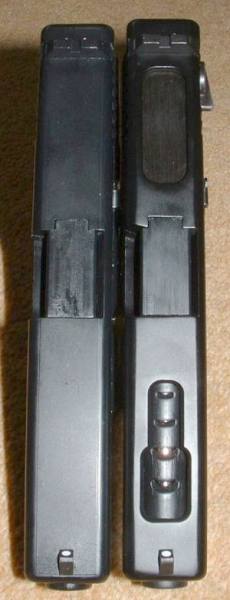
Glock 17 & 18C - KSC
I swapped my Glock 18C for my Prokiller, but when I saw a tatty sounding 18C for a good price on UKAN, I snapped it up with a view to putting a metal slide and barrel on it. A couple of days later, I saw a 17, with no mag (but the 18C had two, albeit one with leaks and no base plate, easily rectified faults) and bought that, too, again with the idea of fitting a metal slide and barrel kit.
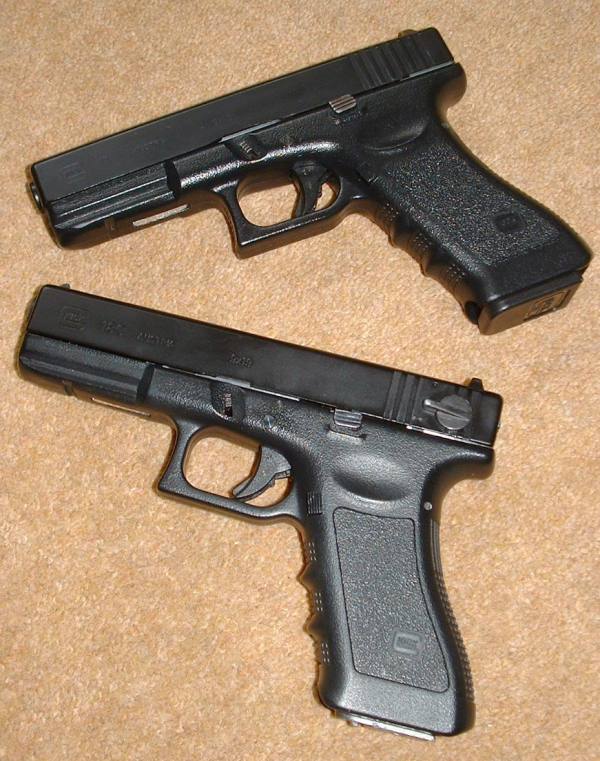
In the Box
The Glock 18C had no box, all I got was the gun, two magazines and a skimpy G18C leaflet - My original gun had come with a 17 manual and a more detailed 18C addendum, plus a loading tool, hop adjustment tool and BBs. The 17, did come in a box, with the loading tool, but there was no manual.
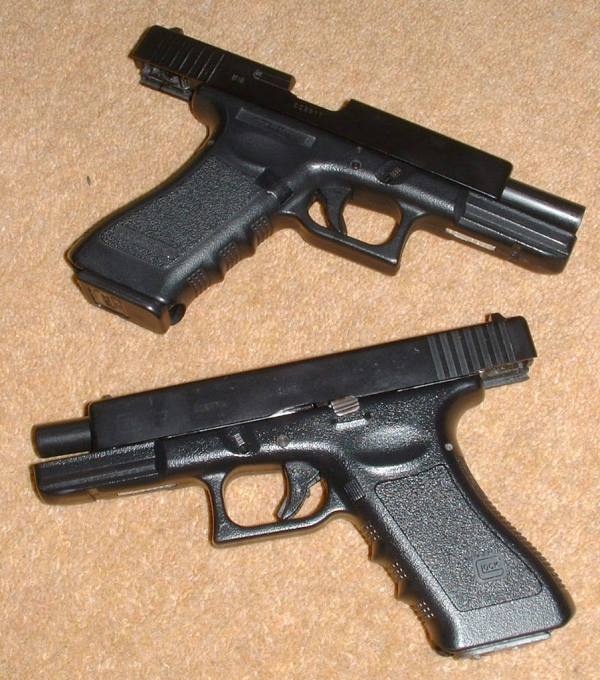
First Impressions
Glock 18C
I was very familiar with the 18C, having owned one for some while. The gun is very simple, externally, with just the selector/safety and disassembly catches breaking up the otherwise plain and boxy exterior. The frame of this 18C is slightly greyish and, as it has the recent rotary Hop-Up adjustment, I wonder if this is a recent change. Otherwise, it's just as my old 18C. Plain, with shallow, but reasonable reproductions of the Glock logos on the slide and grip.

External metal parts on the standard Glock 18C are restricted to the slide lock and the selector/safety. Obviously the metal slide and barrel kit and the metal recoil rod (as fitted standard on the Glock 19 and 26) add those parts, but even the front and rear sights and trigger are plastic.
Glock 17
The Glock 17 is somewhat older than the 18C, as it still has the single slot hop-up adjustment. The frame is also blacker and shinier than the G18C, much closer to the colour and finish of the TM Mk23 NBB.
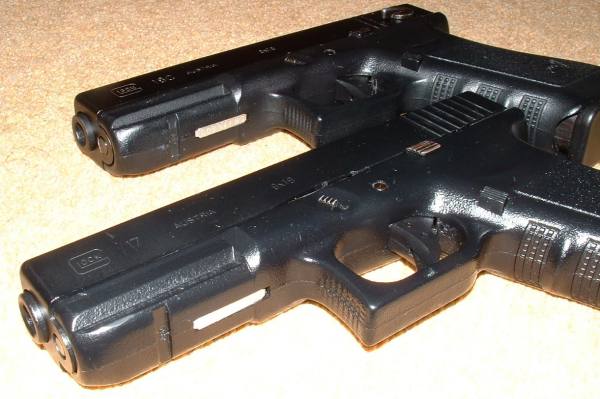
The gun is very, very simple, with none of the cut-outs in the slide seen on the 18C (C = compensator, which vents gas upwards on the real gun to reduce muzzle climb) or the selector on the rear left.
At first sight, this simplicity, as in the real steel, should make the Glock 17 a fine choice for the user looking for a near foolproof handgun.
The ONLY external metal part on the Glock 17 is the slide lock!
Closer Look
Glock 18C
My first task on receiving the Glock 18C (which actually turned out to be in fine fettle), was to strip it down and replace the slide, barrel and recoil rod and spring, with metal/uprated versions. This task was, it seemed, easily accomplished, following the clear instructions on the WGC website.
The metal slide and barrel are both matt black in colour and add greatly to the sound of cocking the gun and to the general heft of the gun in your hand. The engravings on the slide are much deeper and thicker than the standard plastic slide, which adds greatly to the realism.
The markings on the gun are as follows :
Glock logo next to the figure 18C with Austria and 9x19 on the left side of the slide. The grip bears the Glock logo, too. On the right hand side, the frame normally bears the legend "Made in Austria. Glock, Inc. Smyrna GA", but mine is missing and it shows "Made in Taiwan"! The left side of the slide bears a small Glock logo, whilst the barrel is marked "CQB911" followed by some proofing marks. The under barrel serial number plate bears the no "CQB911US".
The underside of the magazine base bears the Glock logo and the number 3206.
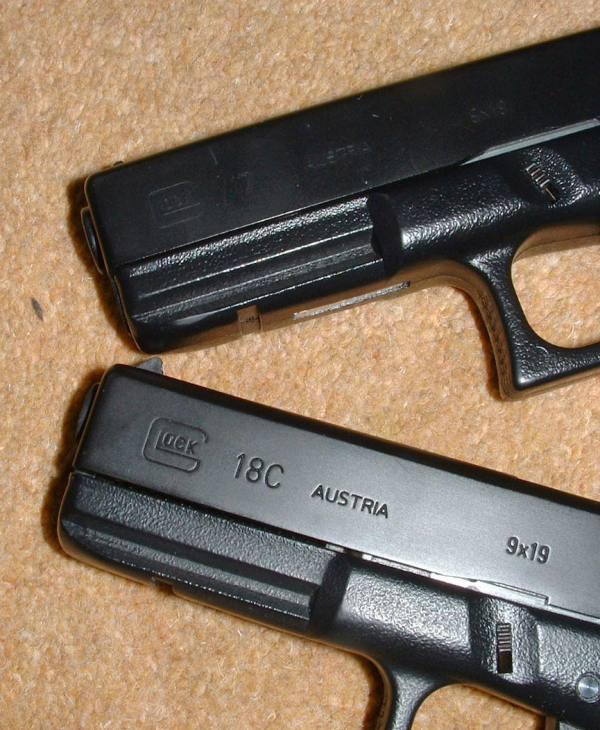
Sadly, this metal slide upgrade (unlike the one I carried out on my Beretta M93R) proved troublesome. Everything went back together fine (I didn't lose any parts or have any over), but every time I fired the gun (in semi or full auto mode), all the gas vented out. As I'd tested it in both modes prior to conversion (with the intention of checking accuracy with and without metal slide upgrade), I knew the problem lay either in my reassembly (which seemed unlikely) or the slide/barrel. I even went as far as to disassemble it and refit the plastic slide and barrel, whereupon everything worked fine again...
As things currently stand, and after fitting the plastic outer barrel with the metal slide for some while, it is now working, at least in semi-automatic mode, but it was a troublesome experience and put me off, possibly unfairly, upgrading the Glock 17 (which for a while I had envisaged polishing the outer barrel of and fitting fibre optic sights to).
With the slide off, a small difference is visible inside the frame, where an extra mechanism disengages the trigger when the selector is set to a central position.
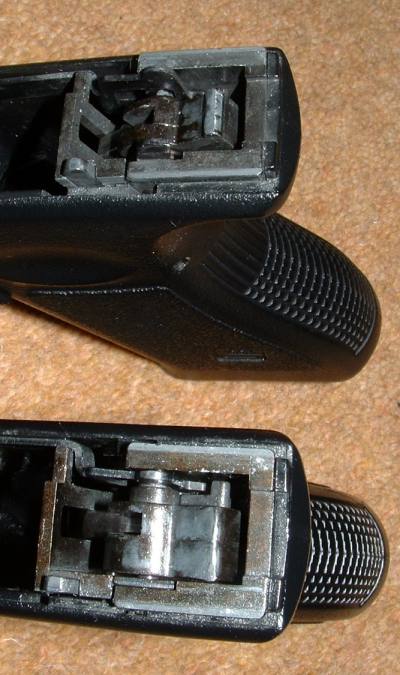
Glock 17
Looking closely at a Glock 17 is fairly pointless; there's little to see. The lack of the selector makes the gun even simpler on the outside (and inside for that matter) than the Glock 18C. The trademarks are very thin and shallow on the slide and the detailing on the barrel and the serial number plate under the frame is similar, but differently serial numbered, to the Glock 18C. The two part trigger is the same on both guns and the frame and slide/barrel are of the same dimensions.
|
As well as not having the front cut-out for the compensator, the slide also lacks the cut out in the rear, making the whole slide, at least theoretically, stronger. Markings on the Glock 17 consist of the Glock logo next to the figure 17 with Austria and 9x19 on the left side of the slide. The grip bears the Glock logo, too. On the left hand side, the frame bears the legend "Made in Austria. Glock, Inc Smyrna, GA". The left side of the slide bears a small Glock logo, whilst the barrel is marked "CSK586" followed by some proof markings. The under barrel serial number plate bears the no "CSK586" The cycling action of both Glocks is sharp and quick, especially noticeable when compared with, say the KSC Mk23 or even their Beretta range. |
Shooting Impressions
Both the Glock 18C and 17 give off a subdued POP when fired. I suspect this is mainly due to their almost entirely plastic construction as it's now less notable on the metal slide equipped 18C.
It's interesting to note that, for all the expensive semi target airsoft guns around, a well shot Glock 17 can still perform very well in BB IPSCC shooting competitions and there's little wrong with the way they shoot.
This Glock 18C, like the one I owned before, in plastic form, was a bit fussy about the quality of BBs it is fed and prone to expel all it's gas when low, but otherwise performed pretty well in both semi and full auto mode. At 5m it was easy to place all the shots in a 3-4 inch circle in either mode, plenty to hit a man-sized target and initial plinking in semi-auto mode with the metal kit suggests that accuracy is, if anything, somewhat better, although that maybe due to me taking more care over shots due to the expectation of gas venting!
The Glock 17, on the other hand, got a proper 5m test. These results are shown on the target below.
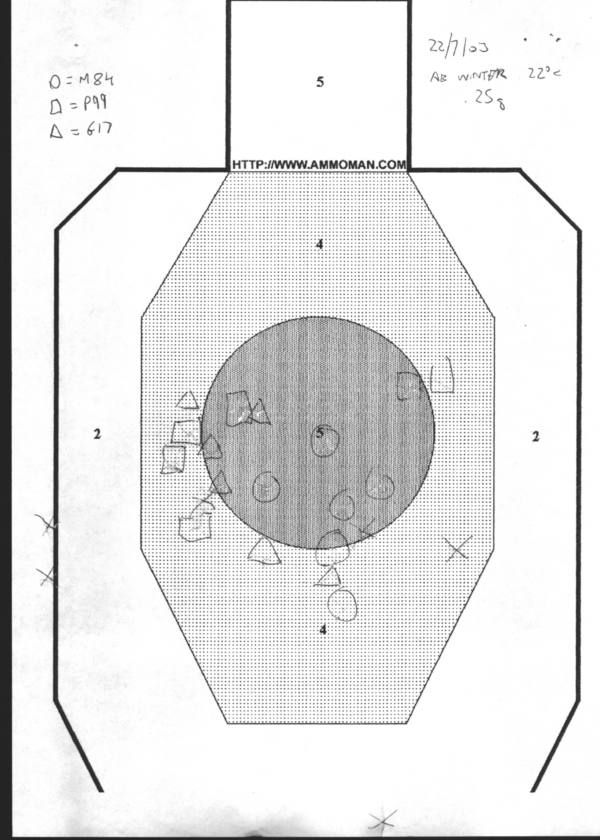
Click on image for bigger version in separate window.
The shots all fall within a 3 inch (8 CM) diameter with 4 within 1.25" (2 CM) diameter, to the left of the aimpoint. The remaining 2 shots were low, but central, in a 1 inch (2.5 CM) diameter.
Certainly usable skirmishing accuracy and, with more practice and zeroing of the sites, probably decent IPSCC standard, too.
UPDATE - Jan 2005 I later acquired a KWA Glock 18C (If there is any difference between this and the KSC version, beyond the box lid artwork, I have yet to find it) and ran it through a chrono test and trigger pull weight test.
Performance was good, if not remarkable, with an average of 267 fps over 10 shots (with Abbey Ultra gas and .2g BBs at 14C).
| Shot | FPS |
| 1 | 272.1 |
| 2 | 280.0 |
| 3 | 264.5 |
| 4 | 271.4 |
| 5 | 254.3 |
| 6 | 273.2 |
| 7 | 270.2 |
| 8 | 267.7 |
| 9 | 260.4 |
| 10 | 256.3 |
Experience suggests this would equate to around 295 fps at 20C.
The trigger pull weight was 780g (28 Oz) a lightish pull for a GBB.
Take Down
Take down on a KSC Glock is very, very simple.
On the 18C, slide the slide back and switch the selector to the central, safe, position. This step is not necessary on the semi-auto Glocks, only the select fire ones.
Drop the magazine and then push the disassembly catches (on either side of the frame, over the trigger) down. The slide, barrel and recoil rod will then push forward off the frame.
The recoil rod can be removed by pushing it gently forward and down and then back. The barrel should be slid forward and down, once clear of the nozzle.
Update - May 2005
I picked up another Glock 18C around Christmas 2004. I then found a Glock 34 barrel for sale and mated the two with a nascent plan to make a Glock 18 replica.
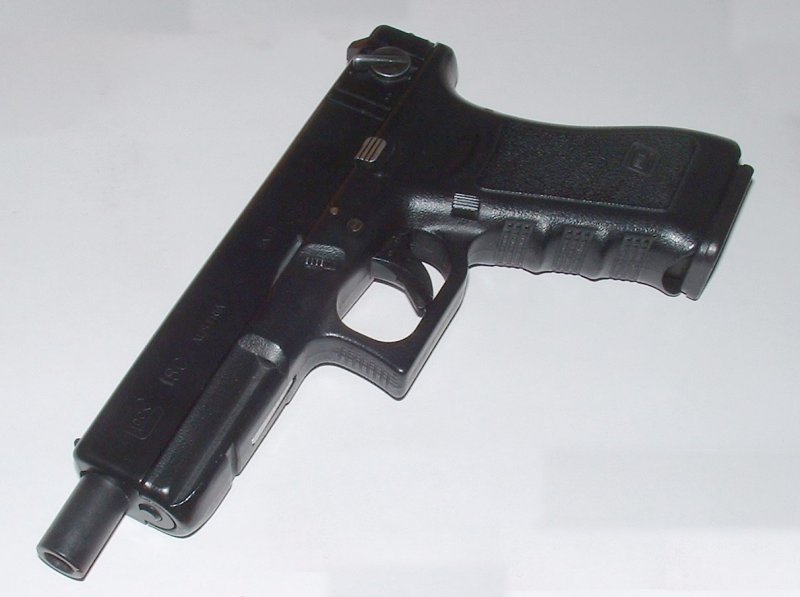
The Glock worked fine and there was an almost imperceptible rise in fps(302 at 20C, rather than 296 with the standard barrel) and improvement in accuracy, presumably due to the longer barrel.
If nothing else, it looked different and, although I didn't progress the project, it would be fairly easy to make an early Glock 18 replica, with the issue of filling in the slide cut-out being the biggest challenge.
Conclusions
Overall, there's a lot to be said for the KSC Glock 17 and 18C as skirmish sidearms. Parts are widely available and the guns are obtainable at very cheap prices, especially as the arrival of KWA variants push the price down. After my experience, I cannot recommend fitting a metal kit yourself (although I had no trouble with the M93R and I'm sure many people have none with the Glocks), but KWA guns are commonly (and more cheaply than upgrading) available already so equipped and the feel and look of the gun is much improved by these kits.
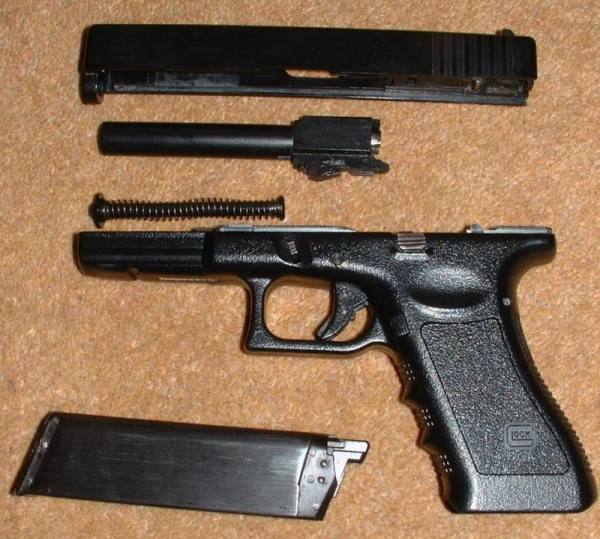
Now my 18C appears to be working, I'm probably going to hang onto it and polish it's outer barrel (this makes more sense, really, as it's visible through the slide vents anyway) and the 17 has already moved onto a new home, where, no doubt, it's doing sterling skirmish sidearm duty.
Weight : 670g / 770g with metal slide and barrel
Realism : ***/***** with metal slide
Quality : ***
Power : ****
Accuracy : ****
Back to the Homepage
